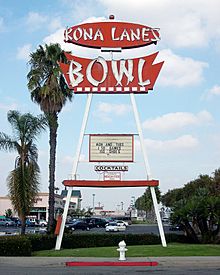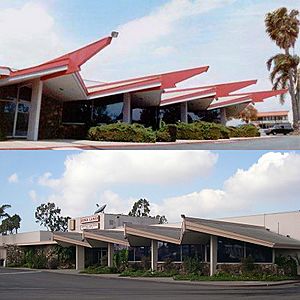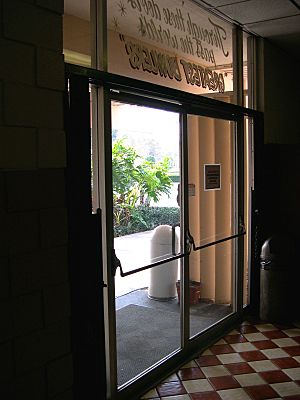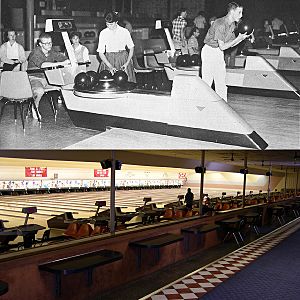Kona Lanes facts for kids

The Kona Lanes Bowl roadside sign
in 2002 |
|
| Former names | New Kona Lanes (1980s) |
|---|---|
| Address | 2699 Harbor Blvd. Costa Mesa, California, U.S. |
| Coordinates | 33°40′16″N 117°55′13″W / 33.671083°N 117.920306°W |
| Owner | Jack Mann Jr. (last) |
| Type | Bowling center |
| Construction | |
| Built | 1958 |
| Opened | 1958 |
| Renovated | 1981 |
| Closed | 2003 |
| Demolished | 2003 |
| Architect | Powers, Daly, & DeRosa |
| Builder | Quigley & Clark |
Kona Lanes was a popular bowling alley in Costa Mesa, California. It opened its doors in 1958 and closed in 2003, after 45 years of fun. This place was famous for its cool, futuristic design, known as "Googie architecture." It also had a fun Polynesian-inspired "Tiki" style.
Kona Lanes had 40 bowling lanes with wooden floors. It also featured a game room, a lounge, and a coffee shop. The coffee shop later became a Mexican diner. The unique Tiki style was everywhere, from its huge neon sign by the road to the building's bright lights and cool roof shape.
When Kona Lanes was torn down in 2003, it was one of the last buildings with this special Googie style in the area. Its sister bowling alley, Java Lanes in Long Beach, was also demolished in 2004. Before Kona Lanes was taken down, much of its equipment was sold. Luckily, its famous sign was saved! It was sent all the way to Cincinnati and is now on display at the American Sign Museum.
After Kona Lanes closed, there were plans to build a department store on the land. But people in the community didn't like this idea, so the plans were stopped. In 2010, the empty land was set aside for apartments for older people and new shops. Construction on the apartments started ten years after Kona Lanes was demolished.
Contents
History of Kona Lanes
Opening the Doors
Kona Lanes first opened in 1958. It quickly became known for its unique Tiki-inspired look and architecture. This style became very popular after World War II. The Los Angeles Times newspaper described its "flamboyant neon lights and flashy rooflines." These features were designed to catch the eye of drivers, like moths to a flame!
The building was located on Harbor Boulevard near Adams Avenue. It was one of three similar buildings designed by architects Powers, Daly, & DeRosa around the same time. Kona Lanes and its sister center, Java Lanes, both had names that sounded like South Pacific islands. Author Andrew Hurley said they were "expensive and attractive buildings that screamed, 'Have fun here!'" Kona Lanes kept this fun atmosphere for many years. Its huge neon sign stayed up for the entire life of the building. Kona was also the only bowling alley in the area that never used automatic scoring equipment.
Kona Lanes hosted the Southern California PBA Open twice in 1964. Famous bowlers Billy Hardwick and Jerry Hale both won tournaments there that year.
Champions and Busy Times
Many amazing bowlers played at Kona Lanes during its 45 years. These included Professional Bowlers Association Tour winner Jack Biondolillo and Bowling Writers Association of America Bowler of the Year Don Carter. John Haveles, who is in the Orange County Bowling Hall of Fame, became Kona's manager in 1974. Other champions like Cora Fiebig, Aleta Sill, Donna Adamek, and Barry Asher also bowled there. Barry Asher, a Hall of Famer, later ran the pro shop at Fountain Bowl nearby.
In 1986, Kona Lanes and Tustin Lanes hosted a huge bowling event. Nearly 10,000 teams of five players each took part in the United States Bowling Congress Women's Championships.
Under the management of Dick Stoeffler, Kona Lanes was busy 24 hours a day. This made him one of the most successful bowling alley owners in the country. He even met his future wife there!
Bowling was very popular in the early 1960s. However, too many bowling alleys were built, which spread out the customers. By the mid-1960s, there were about 11,000 bowling alleys in the U.S. Kona was one of over 30 in southern California alone. The number of people joining bowling leagues started to decline in the 1980s. However, more people started bowling just for fun, which helped keep the customer numbers steady.
Jack Mann bought Kona Lanes in 1980 and renamed it New Kona Lanes in 1981. His family owned several bowling centers in the area. He bought Kona Lanes because he knew it would continue to be a good business. He later sold it to his son, Jack Jr.
Music and Entertainment
The bowling alley had a lounge called the Outrigger Room. Many local musicians performed there over the years.
In later years, parts of the bowling area were used for rock concerts and weekend events like Club Crush. These events were very popular with teenagers and even led to some album recordings. However, one planned event with a local punk rock band was stopped by the Costa Mesa Police Department.
Closing Down
Kona Lanes started to lose business to newer bowling centers. Even though it tried to attract different types of customers by hosting music and having a Polynesian-themed restaurant called Kona Korral, it wasn't enough. Eventually, the land where Kona Lanes stood became more valuable than the business itself. The landowners, C.J. Segerstrom & Sons, gave Jack Mann Jr. a choice: spend a lot of money to update the center, or give it up. Mann chose to give it up because he didn't have a long-term lease for the land.
Plans to build a Kohl's department store on the site were approved by the city. This land also included the already-closed Edwards Cinema Center and Ice Capades Chalet. However, neighbors were against the department store because they felt it didn't fit the area.
New Buildings on the Site
The 7.5-acre piece of land was set aside in 2010 for senior housing. These new apartments were expected to bring more customers to the restaurants and shops already in the area. The land had been empty for about ten years before construction began. The new apartment complex, called Azulón at Mesa Verde, opened in 2014. Many palm and eucalyptus trees from the original site were saved and replanted there.
Kona Lanes' Legacy
The Famous Roadside Sign
The huge, neon KONA LANES BOWL sign became very famous. It was shown in books like The Book of Tiki and Tiki Road Trip. It also inspired professional paintings and was featured in a mural at a local barbershop. In 2003, Costa Mesa Planning Commissioner Katrina Foley worked hard to save the sign from being thrown away.
Thanks to a private donation, the sign was driven 2,500 miles to Cincinnati. It was one of the first 20 signs accepted by the American Sign Museum. The "KONA LANES" part of the sign was fixed up and is now on permanent display. Sadly, the larger "BOWL" section was badly rusted and broke when it was unloaded in Cincinnati, so it could not be saved.





